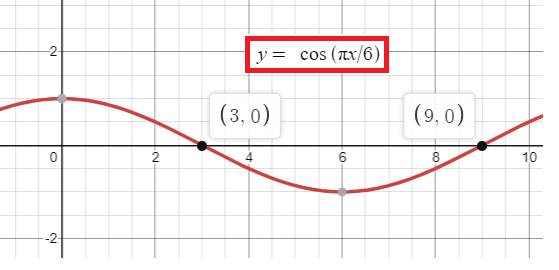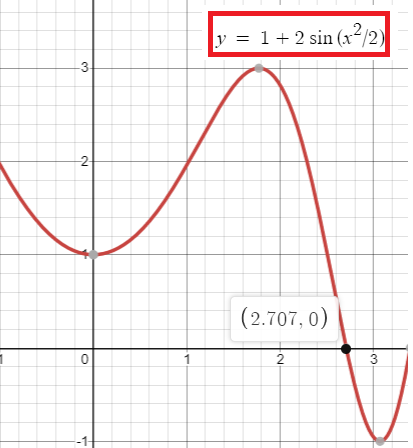VELOCITY AND ACCELERATION PROBLEMS FOR AP CALCULUS
Subscribe to our ▶️ YouTube channel 🔴 for the latest videos, updates, and tips.
Problem 1 :
For 0 ≤ t ≤ 12, a particle moves along the x-axis. The velocity of the particle at time t is given by
v(t) = cos (πt/6).
The particle is at position x = -2 at time t = 0.
(a) For 0 ≤ t ≤ 12 when is the particle moving to the left ?
(b) Write, but do not evaluate, an integral expression that gives the total distance traveled by the particle from time t = 0 to time t = 6.
(c) Find the acceleration of the particle at time t. Is the speed of the particle increasing, decreasing, or neither at time t = 4 ? Explain your reasoning.
(d) Find the position of the particle at time t = 4
Solution :
(a) When the velocity is negative, it shows that the the particle is moving left side.
v(t) = cos (πt/6)
When v(t) = 0
cos (πt/6) = 0
πt/6 = cos-1(0)
πt/6 = π/2, 3π/2
|
πt/6 = π/2 t = 3 |
πt/6 = 3π/2 t = 9 |

v(t) < 0 when 3 < t < 9
(b) ) integral 0 to 6 v(t) dt
(c) v(t) = cos (πt/6)
a(t) = -sin(πt/6) ⋅ (π/6)
a(t) = -(π/6) sin(πt/6)
at t = 4
a(4) = -(π/6) sin(4π/6)
a(4) = -(π/6) √3/2
a(4) = -√3π/12 < 0
v(t) = cos (πt/6)
at t = 4
v(t) = cos (4π/6)
v(t) = cos (2π/3)
v(t) = -1/2 < 0
Since velocity and acceleration have same signs, the speed is increasing.
(d) Find the position of the particle at time t = 4
Given that :
v(t) = cos (πt/6)
The distance at t = 0, x = -2
x(t) = -2 + (Integral t = a to t = b cos (πt/6))
x(4) = -2 + (Integral t = 0 to t = 4 cos (πt/6))
x(4) = -2 + [sin(πt/6)/(π/6)] t = 0 to t = 4
x(4) = -2 + (6/π) [sin(πt/6)] t = 0 to t = 4
x(4) = -2 + (6/π) [sin 0 - sin (2π/3)]
x(4) = -2 + (6/π) (- √3/2)
x(4) = -2 -(3√3/π)
Problem 2 :
For t ≥ 0, a particle moves along the x axis. The velocity of the particle at time t is given by
v(t) = 1+2sin(t2/2)
The particle is at position x = 2 at time t = 4.
(a) At time t = 4, is the particle speeding up or slowing down.
(b) Find all times t in the interval 0 < t < 3, when the particle changes its direction. Justify your answer.
(c) Find the position of the particle at time t = 0.
Solution :
(a) v(t) = 1+2sin(t2/2) (Given)
at t = 4
v(4) = 1+2sin(42/2)
v(4) = 1+2sin8
= 1 + 2(0.9893)
= 1+1.9786
v(4) = 2.9786
v(t) = 1+2sin(t2/2)
a(t) = 0+2cos(t2/2)(2t/2)
a(t) = 2tcos(t2/2)
a(4) = 8cos8
= 8(-0.1455)
a(4) = -1.164
Both velocity and acceleration having same sings, so the particle is speeding up.
(b) v(t) = 0
v(t) = 1+2sin(t2/2)
using graphing calculator, finding x-intercepts we get

v(t) changes its direction from positive to negative at
t = 2.707.
(c) Find the position of the particle at time t = 0.
x(0) = ?
x(t) = 2 + integral 4 to 0 v(t)
x(4) = 2 + integral 4 to 0 (1+2sin(t2/2)) dt
Let u = t2/2
du = (2t/2) dt
du = t dt
t = √(2u)
dt = du/√(2u)
x(4) = 2 + integral 8 to 0 (1+2sinu) du/√(2u)
x(4) = -3.815
Problem 3 :
The position of the particle is given as
x(t) = cos 3t - sin 4t
Find the acceleration at t = 0.
(A) -9 (B) 0 (C) 1 (D) 2 (E) 16
Solution :
Given that,
x(t) = cos 3t - sin 4t
Finding velocity :
x'(t) = -sin 3t ⋅ (3) - cos (4t) ⋅ 4
= -3 sin 3t - 4 cos (4t)
Finding acceleration :
x'(t) = -3 sin 3t - 4 cos (4t)
x''(t) = -3 cos 3t ⋅ (3) + 4 sin (4t) ⋅ 4
x''(t) = -9 cos 3t + 16 sin (4t)
Acceleration at t = 0,
x''(0) = -9 cos 3(0) + 16 sin 4(0)
= -9 cos 0 + 16 sin 0
= -9(1) + 16(0)
= -9
Problem 4 :
s(t) = t2 - 4t - 96
A particle moves along a horizontal line. Its position function is s(t) for t ≥ 0. For each problem, find the intervals of time when the particle is slowing down and speeding up.
Solution :
s(t) = − t2 + t + 72
Finding velocity :
v(t) = −2t + 1
v(t) = 0
−2t + 1 = 0
2t = 1
t = 1/2
Finding acceleration :
a(t) = V'(t) = -2(1) + 0
= -2
There is no values for t.
Decomposing into intervals :
(0, 1/2) and (1/2, ∞)
|
x = 0.3 ∈ (0, 1/2) v(t) = −2t + 1 v(0.3) = −2(0.3) + 1 = -0.6 + 1 = 0.4 < 0 |
x = 0.6 ∈ (1/2, ∞) v(t) = −2t + 1 v(0.3) = −2(0.6) + 1 = -1.2 + 1 = -0.2 < 0 |
In the interval (0, 1/2),
0.4 (-2) = -0.8 < 0 (slowing down)
In the interval (1/2, ∞),
-0.2(-2) = 0.4 > 0 (speeding up)
Subscribe to our ▶️ YouTube channel 🔴 for the latest videos, updates, and tips.
Kindly mail your feedback to v4formath@gmail.com
We always appreciate your feedback.
About Us | Contact Us | Privacy Policy
©All rights reserved. onlinemath4all.com

Recent Articles
-
10 Hard SAT Math Questions (Part - 42)
Dec 30, 25 05:52 AM
10 Hard SAT Math Questions (Part - 42) -
10 Hard SAT Math Questions (Part - 38)
Dec 29, 25 04:21 AM
10 Hard SAT Math Questions (Part - 38) -
10 Hard SAT Math Questions (Part - 39)
Dec 28, 25 11:20 PM
10 Hard SAT Math Questions (Part - 39)
